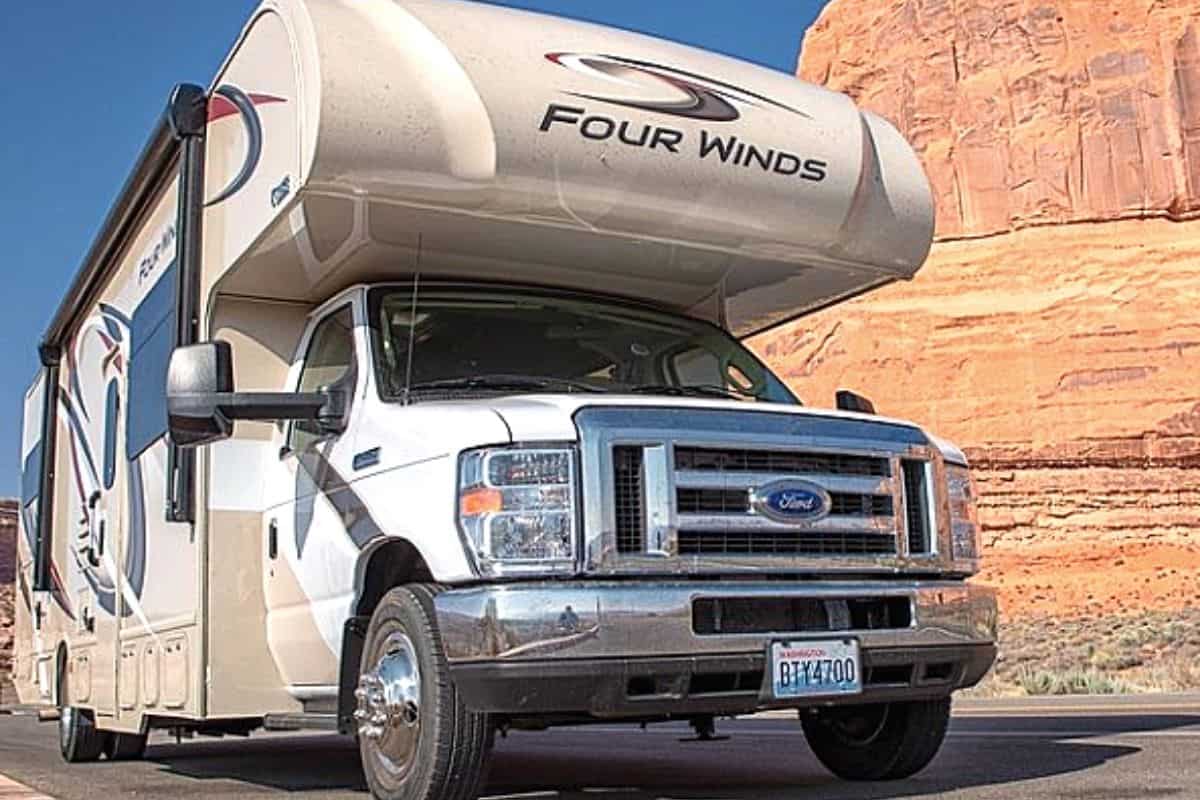The Ford V10 engine is one of the most popular and powerful gas engines in RVs today.
With all that power though, you might be wondering what kind of gas mileage the Ford V10 gets in an RV.
Well, it’s not pretty but here’s the answer.
The Ford V10 engine in an RV will usually get between 6 to 10 miles per gallon, however, this can vary depending on the length as well as the weight of the RV.
While the average miles per gallon might seem extremely low, it is comparable to other engines of similar size and displacement.
If you have an RV with a Ford V10 or thinking about buying one though, there is a lot more to know than just its average MPG.
So if you’re curious about how to get better gas mileage with the Ford V10 and what the life expectancy of a Ford V10 engine is, keep reading.
RV Ford V10 Gas Mileage (With Specific Examples)
Now that we know the typical average miles per gallon of a Ford V10 engine in an RV, let’s take a closer look at some specific examples, to get a better idea of gas mileage based on the motorhome’s class, as well as its weight, and length.
| Make/Model/Trim | Class | Length | GVWR | Average MPG |
|---|---|---|---|---|
| 2016 Fleetwood Bounder 33C | A | 34′ 3″ | 22,000 lbs | 6.5 |
| 2016 Newmar Bay Star Sport 3004 | A | 30′ 11″ | 20,500 lbs | 7 |
| 2016 Thor Vegas 24.1 | A | 25′ 6″ | 12,500 lbs | 10 |
| 1999 Airstream Land Yacht 355XL | A | 35′ | 20,500 lbs | 7.5 |
| 2019 Winnebago Outlook 22C | C | 24′ 2″ | 11,500 lbs | 8 |
| 2019 Winnebago Minnie Winnie 22R | C | 23′ 10″ | 11,500 lbs | 8 |
| 2016 Forest River Sunseeker 2500TS | C | 26′ 11″ | 14,500 lbs | 8 |
| 2000 Winnebago Minnie Winnie DL | C | 29′ 4″ | 14,050 lbs | 8 |
| 2000 Fleetwood TIOGA 26F | C | 26′ 11″ | 14,050 lbs | 10 |
How to Get Better Gas Mileage Out of a Ford V10
While a Ford V10 engine is never going to get great gas mileage, there are many things you can do to help improve the fuel efficiency of the engine.
Keep it between 55 and 60 MPH for the Best Fuel Efficiency
Most vehicles including those with Ford V10 engines are most fuel-efficient between 55 and 60 mph, due to the increased wind resistance as well as rolling resistance experienced at higher speeds.
In fact, fuel efficiency dramatically drops off for every 5 miles above this ideal range, according to the Department of Energy, as you can see from the table below.
| Miles Per Hour | Fuel Efficiency |
|---|---|
| 60 | 3% less fuel-efficient |
| 65 | 8% less fuel-efficient |
| 70 | 17% less fuel-efficient |
| 75 | 23% less fuel-efficient |
| 80 | 28% less fuel-efficient |
Make Sure Your Air Filter is Clean and Free From Debris
The air filter on a Ford V10 engine is how the engine breaths and a clogged or dirty air filter can greatly reduce the fuel efficiency of the engine when running.
By replacing or cleaning a dirty air filter on the Ford V10 engine you can expect to see a 10% improvement in fuel efficiency.
Keep Your Tire Pressure at the Recommended PSI for Better Fuel Efficiency
One of the most common culprits of poor fuel efficiency is under-inflated tires.
So make sure to check the PSI or pounds per square inch of your tires regularly with a tire pressure gauge like this popular one on Amazon, to make sure they are at the manufacturer’s recommended pressure.
For the most accurate tire pressure reading make sure to check your tire pressure while the tires are cold and before driving one mile.
Checking and correcting your tire’s pressure to the proper PSI can increase fuel efficiency by 3%, as well as help to prevent premature wear on the tires.
Keep the Idling to a Minimum to Improve Miles Per Gallon
While this might seem like an obvious tip, excessive idling is another big fuel waster and can greatly reduce the overall fuel efficiency of your vehicle.
So if your vehicle is idling for more than 10 seconds shut it off and you will be amazed by the improvement of your fuel efficiency.
Use the OverDrive Feature and Set the Cruise Control
Using the overdrive feature on your engine can help to improve the fuel efficiency of your Ford V10 as it reduces the RPMs or revolutions per minute of the engine.
Also, if you’re on the interstate or highway use your cruise control whenever possible, as this will keep your vehicle at a constant speed.
Because a vehicle driving at a constant speed will get far better fuel efficiency compared to one that is constantly slowing down and speeding back up again.
Keep Your Engine Tuned Up for the Best Fuel Efficiency
One of the best things you can do to keep your fuel efficiency at its max with a Ford V10 engine is to keep the engine tuned up and in top working order.
As a poorly tuned engine can reduce fuel efficiency by as much as 10 to 20 percent. And poor emissions or a faulty oxygen sensor can reduce fuel efficiency by as much as 40%!
Reduce the Weight in Your Vehicle
We are all guilty of traveling with items or stuff we don’t need.
And while it might not seem like a big deal, keeping your vehicle as light as possible can greatly improve the fuel efficiency of your Ford V10.
Why RVs Use Ford V10 Engines

Many RV manufacturers including Coachmen, Thor, and Winnebago have long used the Ford V10 engine for their RVs because of its excellent low-end torque, ample horsepower, reliability, and economical price.
Ford first brought their 6.8L V10 engine onto the market in 1997 as an upgrade to the Ford V8 for consumers and applications needing more low-end torque.
There have been many redesigns and revisions over the years to the Ford V10 engine that have made incremental improvements, bringing its current output levels to 362 horsepower and 460 lb-ft of torque, which by any standards is a powerful engine.
While the Ford V10 doesn’t provide as much torque as a diesel engine, it still provides a ton of torque, especially for a gasoline engine.
Do RVs Still Use the Ford V10 Engine?
The Ford V10 Triton was widely used in the RV industry as a preferred powertrain for both Class A and especially Class C RVs.
Thanks to its ample horsepower and robust low-end torque.
However, the Ford V10 wasn’t perfect, because while it was generally reliable, it did have its issues, including spark plug blowouts, PCV valve hose cracks, and exhaust manifold bolt failures.
Which were addressed throughout the 20+ year history of the Triton V10.
As the years dragged on though, the engine was definitely starting to show its age, so in 2019 Ford discontinued all production of the V10, including in its E-Series van.
Which is the chassis used on Ford Class C RVs.
Replacing the 6.8-liter V10 with the new and improved “Godzilla” 7.3-liter V8 that produces 335 horsepower and 468 lb-feet of torque.
Because of this, 2019 and 2020, were transition years in the RV industry, where you could find new RVs on the lot using both the old Triton V10 and the new Godzilla V8.
By 2021, however, all RV models using the old Triton V10 were essentially sold off, and the only engine option available from then on was the new 7.3-liter V8.
Which was widely celebrated as a great improvement over the old V10.
How Long Does a Ford V10 Engine Last?
The Ford V10 engine will typically last anywhere from 150,000 to 250,000 miles.
While the Ford V10 engine is certainly not the longest-lasting engine on the market, it does provide a lot of reliability for its economical price and lower maintenance costs compared to other more expensive and longer-lasting engines.
What is the Average Miles Per Gallon of an RV?
Miles per gallon can vary significantly on RVs thanks to the wide variety of classes as well as lengths and weights.
So we broke down the average miles per gallon of an RV based on the class of the RV, to get a more accurate representation of miles per gallon.
| Motorhome Class | Average Miles Per Gallon |
|---|---|
| Class A | 6 to 12 |
| Class B | 18 to 25 |
| Class C | 7 to 15 |
What RV Gets the Best Gas Mileage?
There are a wide variety of RVs and motorhomes on the market today that offer a wide range of miles per gallon.
Because of this, we’ve chosen three RVs, one from each Class that offers the best fuel efficiency.
After all, it wouldn’t be fair to compare a 40-foot Class A motorhome to a 20-foot Class B campervan.
Because of course, the Class B would win out, as it’s half the length and half the weight of a Class A.
Best Class A RV for Gas Mileage: Newmar Dutch Star

The diesel Newmar Dutch Star is one of the best Class A motorhomes on the market today for gas mileage, getting between 8 to 11 miles per gallon on average.
Which is pretty amazing, considering the motorhome is over 40 feet long with a gross vehicle weight rating of 51,000 pounds!
Best Class B RV for Gas Mileage: Roadtrek Sprinter RS Adventurous

If you’re looking for the best fuel efficiency when it comes to RVs, the Roadtrek Sprinter RS Adventurous is hard to beat, as this Class B RV gets an amazing 17 to 23 miles per gallon.
There are two main reasons why the Roadtrek Sprinter RS Adventurous is able to achieve these great MPG numbers, which include its diesel engine as well as its shorter length and lighter gross weight, coming in at 22 feet 9 inches and 11,030 pounds.
Best Class C RV for Gas Mileage: Winnebago Navion

While some might consider the Winnebago Navion more of a Class B+ rather than a true Class C, the Navion is, in fact, a Class C motorhome and it has one of the best fuel efficiency ratings for a Class C.
Getting between 18 and 20 miles per gallon on average.
Much like the Roadtrek Sprinter RS Adventurous from above, the Winnebago Navion achieves its best-in-class miles per gallon thanks to its diesel engine as well as its shorter length and lighter gross weight, coming in at 25 feet 5 inches and 11,000 pounds.
Recent Posts
When cruising down the highway in your RV, the last thing you want is a tire blowout! Not only is it dangerous, but RV tire replacement isn't cheap, costing $200 to $300 per tire. The good news,...
Nothing ruins an RV adventure faster than a breakdown with no way to fix it. Because of this, every RVer should have a well-stocked RV tool kit for those unexpected roadside emergencies and campsite...

